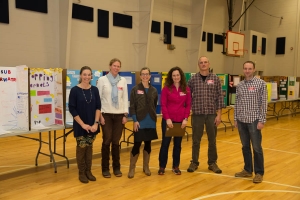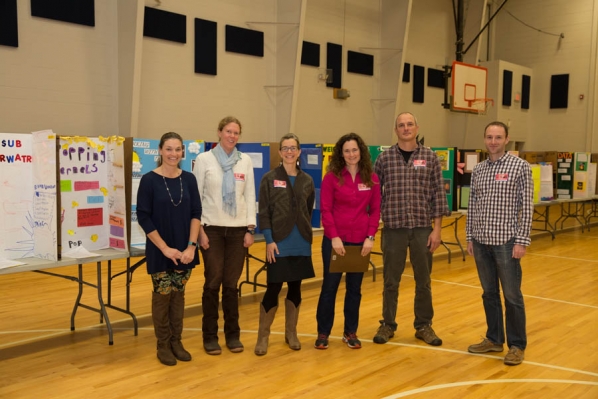Six faculty members from the College of Arts and Sciences in mid-November judged Science Fair projects completed by fourth, fifth and sixth graders at Blue Ridge Elementary School in Ashe County. Blue Ridge Elementary School (BRES) is about a forty-five-minute drive from Appalachian State University’s campus serving a population of 525 students in grades kindergarten through sixth.
 Dr. Dana Powell, assistant professor in the Department of Anthropology, organized faculty colleagues in STEM departments to judge more than 150 science fair projects by BRES students. The involved faculty included Dr. Tonya Coffey, Physics; Dr. Jamie Levine, Geology; Dr. Michael Madritch, Biology; Dr. Bob Swarthout, Chemistry and Environmental Science; Dr. Saskia van de Gevel, Geography & Planning; and Dr. Gypsy Price, Anthropology. Powell, who has children in Ashe County Schools, would like to see stronger connections between University STEM and arts faculty with the surrounding rural public schools.
Dr. Dana Powell, assistant professor in the Department of Anthropology, organized faculty colleagues in STEM departments to judge more than 150 science fair projects by BRES students. The involved faculty included Dr. Tonya Coffey, Physics; Dr. Jamie Levine, Geology; Dr. Michael Madritch, Biology; Dr. Bob Swarthout, Chemistry and Environmental Science; Dr. Saskia van de Gevel, Geography & Planning; and Dr. Gypsy Price, Anthropology. Powell, who has children in Ashe County Schools, would like to see stronger connections between University STEM and arts faculty with the surrounding rural public schools.
“Teachers at Blue Ridge Elementary School are creative, committed and highly engaged in developing rigorous science and arts programming for young children. Appalachian has historically done far more outreach and service in Watauga County schools than in Ashe, and it’s time we work to close this gap in science, technology, engineering, math and arts resources.”
 Tania Rollins, teacher and curriculum coach at BRES prepared each volunteer judge with a rubric for evaluating the science projects and organized students to take time outside of the classroom for interviews with the Appalachian faculty about their experiments.
Tania Rollins, teacher and curriculum coach at BRES prepared each volunteer judge with a rubric for evaluating the science projects and organized students to take time outside of the classroom for interviews with the Appalachian faculty about their experiments.
“This was the most efficient Science Fair we have ever conducted. The Appalachian faculty were extremely helpful in streamlining the judging process. They were very professional and well received by students and faculty. Blue Ridge Elementary School is extremely grateful for their time and hopes that in the future they can continue to judge our Science Fair,” said Rollins.
After the judging was completed, a Science Night was hosted at the school with parents and families in attendance. Each grade showcased a different project with a scientific theme from life cycle projects to animal habitats to skeletons.
 Creative arts were also incorporated into the evening. The featured exhibit was a Paleolithic cave art project created in an enclosed hallway adjoining the gymnasium. BRES Art teacher Elizabeth Lauer, originally from Kansas City, Missouri, graduated from Appalachian in 2013 with a BS in Art Education. She joined the teaching staff at BRES two years ago, and this fall, introduced elementary students to a unit focusing on the remarkable visual arts from the Paleolithic era.
Creative arts were also incorporated into the evening. The featured exhibit was a Paleolithic cave art project created in an enclosed hallway adjoining the gymnasium. BRES Art teacher Elizabeth Lauer, originally from Kansas City, Missouri, graduated from Appalachian in 2013 with a BS in Art Education. She joined the teaching staff at BRES two years ago, and this fall, introduced elementary students to a unit focusing on the remarkable visual arts from the Paleolithic era.
With Powell’s assistance, Lauer connected with two undergraduate anthropology students, Catherine Herring and Taylor Reynolds in Dr. Larry Kimball’s Paleolithic Cave Art seminar, bringing them to BRES for Science Night to assist Lauer in educating students and their families on Paleolithic cave art. Lauer and the anthropology students were joined by Matt LeBlanc, art education student from Appalachian who is completing his student teaching placement with Lauer in her classroom at BRES.
“I enjoy teaching art lessons that relate to the units of study that students are working on in their homeroom classes. The sixth-grade science and social studies teacher mentioned that she was starting from the beginning with her students in history. I also started from what I know as the beginning of art history, Paleolithic art,” said Elizabeth Lauer, Art teacher at BRES.
 In preparation for their Science Night installation, Lauer led the sixth-grade students through a virtual tour of the Chauvet cave in France, viewing the symbols, animals and hand silhouettes inside. Then using spray bottles of water, powdered tempera paint and crumpled up paper, students recreated outlines of their own hands. Then the students were challenged to create symbols, representing how they would like to be remembered 40,000 years from now.
In preparation for their Science Night installation, Lauer led the sixth-grade students through a virtual tour of the Chauvet cave in France, viewing the symbols, animals and hand silhouettes inside. Then using spray bottles of water, powdered tempera paint and crumpled up paper, students recreated outlines of their own hands. Then the students were challenged to create symbols, representing how they would like to be remembered 40,000 years from now.
“I didn't feel like a bulletin board display would communicate the students’ interpretations of cave paintings as well as a hallway-turned-cave that the students were all in favor of creating!” said Lauer.
On Science night, anthropology students Herring and Reynolds stood at the mouth of the cave to explain the historical era, while families of BRES students were fully immersed in the experience with battery powered tea lights to guide them through the cave, viewing the  artwork as early explorers.
artwork as early explorers.
“I think the ties between science and the visual arts are strong and I am open to any opportunity to further those connections. I appreciate the willingness of Appalachian faculty and students to share their time and knowledge with the Blue Ridge Elementary School community” said Lauer.
###
About the Department of Anthropology
The Department of Anthropology offers a comparative and holistic approach to the study of the human experience. The anthropological perspective provides a broad understanding of the origins as well as the meaning of physical and cultural diversity in the world – past, present and future. The department offers numerous research opportunities for students including field schools, internships, lab projects and independent studies at home and abroad. Students may earn B.A. and B.S. degrees with concentrations in sociocultural anthropology, archaeology, biological anthropology, and social practice and sustainability.
About the Department of Art
One of seven departments housed in the College of Fine and Applied Arts, the Department of Art at Appalachian State University prepares students to explore art, identity, expression and creative problem-solving while challenging them to go beyond their previous limits by discovering new connections to culture. The department offers degrees in art and visual culture, art education, graphic design, studio art, commercial photography and graphic arts and imaging technology, with minors in art history, studio art, commercial photography and graphic arts and imaging technology.
About the College of Arts and Sciences
The College of Arts and Sciences is home to 16 academic departments, two stand-alone academic programs, two centers and one residential college. These units span the humanities and the social, mathematical and natural sciences. The College of Arts and Sciences aims to develop a distinctive identity built upon our university's strengths, traditions and unique location. Our values lie not only in service to the university and local community, but through inspiring, training, educating and sustaining the development of our students as global citizens. There are approximately 5,850 student majors in the college. As the college is also largely responsible for implementing Appalachian's general education curriculum, it is heavily involved in the education of all students at the university, including those pursuing majors in other colleges. Learn more at http://cas.appstate.edu.
By Ellen Gwin Burnette
Jan. 10, 2017
BOONE, N.C.

